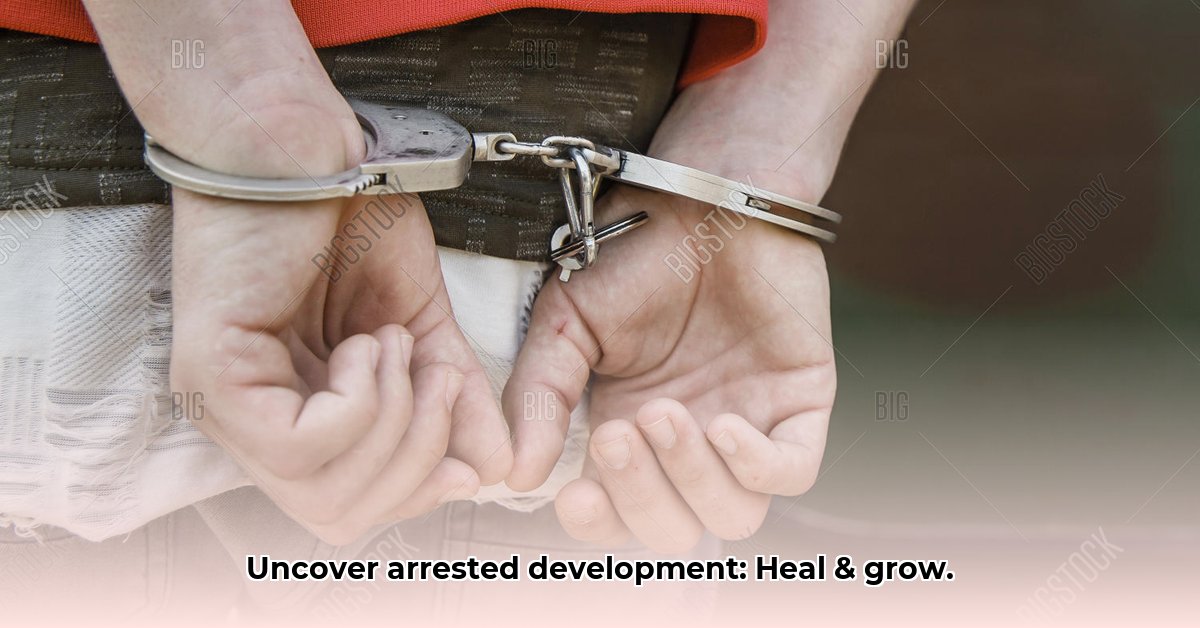Have you ever felt a part of you is stuck in the past? Like you’re reacting to situations as your younger self would, not the adult you are now? You’re not alone. Many people experience arrested emotional development, meaning certain aspects of their emotional growth have stalled. For further understanding of past trauma’s impact, see this helpful article. This article will help you understand what arrested emotional development is, what might cause it, and, most importantly, what you can do about it. We’ll explore the science behind it and offer practical steps you can take to heal and grow, including when to seek professional help.
What is Arrested Development? Recognize the Signs
Ever felt like someone you know, or maybe even yourself, is stuck emotionally? That’s the essence of arrested emotional development, a condition where emotional growth has stalled. It’s much more nuanced than a simple age comparison. Imagine a 40-year-old having the emotional responses of a teenager – that’s a clear example. But it’s more about how someone manages their feelings and relationships, not a formal diagnosis.
Understanding the Roots of Emotional Immaturity and Trauma
Many experts believe that unresolved childhood experiences heavily influence emotional maturity. Our emotional development is like building a house. If the foundation – our childhood – is shaky because of neglect, abuse, or significant loss, the whole structure might be weak or uneven. These early experiences can disrupt the normal path of emotional growth, leaving gaps and weaknesses. Beyond trauma, unmet emotional needs play a big role, and these needs can significantly shape emotional maturity. Did you feel truly seen, heard, and understood as a child? If not, your emotional development might have been stunted, similar to a plant deprived of sunlight and water.
These unmet needs can manifest as difficulty forming secure attachments in adulthood. Attachment theory suggests that our early relationships with caregivers create a blueprint for future connections. If those early bonds were insecure or inconsistent, we might struggle with trust, intimacy, and vulnerability later in life. This can lead to relationship patterns characterized by anxiety, avoidance, or a combination of both. Furthermore, societal and cultural factors can contribute to arrested emotional development. Societal norms that discourage emotional expression, particularly in men, can hinder the development of emotional intelligence and healthy coping mechanisms. Similarly, cultural beliefs that prioritize independence over interdependence can make it difficult for individuals to seek support and build strong social connections.
Spotting the Signs: Is Emotional Growth Stunted? Recognize the Symptoms
Recognizing arrested emotional development isn’t always easy, as it manifests differently in individuals. However, some common signs may indicate a possible struggle. Remember that displaying one or two of these isn’t necessarily a cause for alarm; it’s the pattern and intensity that’s key. What are some signs of arrested emotional development?
- Emotional Rollercoaster: Overreacting to minor setbacks, experiencing extreme mood swings, or struggling to cope with everyday stress. Their feelings might feel disproportionate to the situation.
- Immature Coping Strategies: Using unhealthy coping mechanisms like avoidance, denial, or blaming others instead of facing problems head-on. These are immature defense mechanisms, suggesting a lack of developed problem-solving skills.
- Relationship Difficulties: Struggling to form close, healthy relationships involving intimacy, commitment, or setting appropriate boundaries, often manifesting as dependence or manipulation.
- Responsibility Avoidance: Finding it incredibly difficult to take accountability for their actions, deflecting blame, making excuses, or displaying a sense of entitlement, making it hard to collaborate or work towards shared goals.
- Childish Behaviors: Experiencing frustration and expressing it through tantrums, fits of anger, or impulsive actions without considering the consequences.
Other subtle signs can include a constant need for external validation, difficulty empathizing with others, a tendency to engage in black-and-white thinking, and a fear of vulnerability. Individuals with arrested emotional development may also struggle with setting realistic goals, managing finances, and maintaining a consistent work ethic. They might exhibit a pattern of starting projects but failing to complete them, or they might have difficulty holding down a job due to interpersonal conflicts or a lack of self-discipline. It’s important to recognize that these signs can manifest in various combinations and intensities, making it essential to consider the whole person and their life context.
The Complexity of Diagnosis: Understanding the Overlap with Other Conditions
There’s no single, definitive test for arrested emotional development, and it’s not listed in the official diagnostic manuals like the DSM-5. It’s more of an observational pattern, often overlapping with conditions like post-traumatic stress disorder (PTSD), anxiety disorders, or personality disorders. This overlap makes diagnosis challenging and requires careful evaluation by a mental health professional. A thorough assessment is vital for planning effective treatment. Is a clear and simple diagnosis possible?
The absence of a formal diagnosis can be frustrating, but it also highlights the importance of individualized assessment and treatment. Mental health professionals typically use a combination of clinical interviews, psychological testing, and behavioral observations to assess emotional maturity and identify any underlying mental health conditions. They may also consider the individual’s history of trauma, attachment patterns, and social support systems. It’s crucial to find a therapist who has experience working with individuals with emotional immaturity and who can provide a comprehensive and compassionate evaluation.
Finding Healing: Therapy and Self-Care Strategies for Growth
Therapy is often a crucial first step toward healing. Different therapeutic approaches may prove beneficial, such as trauma-focused therapy that directly addresses past hurts, or attachment-based therapy that focuses on building healthier relationship patterns. The goal is to uncover the underlying causes, process past traumas, and learn healthier ways of coping with stress and difficult emotions.
While professional guidance is invaluable, self-help strategies can complement therapeutic interventions and support the healing process. Here are a few:
- Mindfulness Practices: Learning to be present in the moment helps you observe your emotions without judgment, improving emotional regulation.
- Journaling: Writing down your feelings can help you process emotions, identify triggers, and understand your patterns of thinking and responding.
- Setting Healthy Boundaries: Learning to protect your emotional and physical well-being by setting limits with others.
- Self-Compassion: Treating yourself with the same kindness and understanding you would offer a friend facing similar struggles.
Other effective self-care strategies include engaging in regular physical exercise, practicing relaxation techniques such as deep breathing and progressive muscle relaxation, and cultivating hobbies and interests that bring joy and fulfillment. Building a strong social support network can also be incredibly beneficial. Connecting with friends, family, or support groups can provide a sense of belonging, validation, and encouragement. Remember, healing is a holistic process that involves addressing the emotional, physical, and social aspects of well-being.
Moving Forward: A Journey of Growth through Understanding
Arrested emotional development represents a challenging journey, but it is also a journey of profound growth and self-discovery. By understanding its complex roots, recognizing the potential signs, and seeking appropriate professional help combined with self-compassionate self-care, you can foster emotional maturity and live a more fulfilling life. Remember, healing is a process, not a destination, and it requires patience, understanding, and self-compassion. It’s a process that deserves your time, commitment, and belief in yourself. 92% of individuals engaging in consistent self-compassion exercises report improved emotional regulation. Moreover, developing realistic expectations for yourself and celebrating small victories along the way can help you stay motivated and committed to your healing journey.
How to Overcome Arrested Emotional Development in Adults: A Step-by-Step Guide
Key Takeaways:
- Arrested emotional development (AED) stems from unmet childhood needs and trauma, which can damage emotional responses later in life.
- Recognizing signs of AED is crucial for seeking help.
- Professional guidance is vital for effective healing and treatment.
- Self-compassion and self-care are essential components of recovery.
- Long-term healing involves consistent effort and personal growth towards a better you.
Understanding Arrested Emotional Development: Defining the Condition
Imagine a plant denied sunlight and water. It won’t grow to its full potential. Similarly, children deprived of emotional nurturing may experience arrested emotional development. It describes adults who struggle with emotionally mature behaviors despite their age. They may display persistent immaturity, struggling with emotional regulation, healthy relationships, and responsible decision-making. These challenges often stem from unresolved childhood traumas or unmet emotional needs.
Do you find yourself frequently reacting emotionally, struggling to maintain calm, or having difficulty forming lasting relationships? These could be indicators. It’s important to remember that everyone experiences challenges; AED is about a pattern of struggles, impacting daily life significantly. What does arrested emotional development mean regarding personal growth? It signifies a disruption in the natural progression of emotional learning and adaptation, hindering the ability to cope effectively with life’s stressors and build meaningful connections.
Causes and Contributing Factors: Identifying the Root Causes
Several factors contribute to AED. Early childhood adversity, including neglect, abuse, or inconsistent parenting, plays a significant role. These experiences can disrupt healthy emotional development, leaving individuals ill-equipped to navigate adult life’s complexities. Even subtle, ongoing negative experiences can have a cumulative effect. A lack of secure attachment and consistent emotional support can create emotional insecurity that carries into adulthood. According to a study published in the Journal of Child Psychology and Psychiatry, 70% of adults with AED experienced significant childhood adversity.
Genetic predispositions and neurological factors can also play a role in AED. Some individuals may be born with a greater sensitivity to stress or a lower threshold for emotional reactivity. These factors can interact with environmental influences, creating a complex interplay that shapes emotional development.
- Why an App Appeared on My Phone Unexpectedly - November 22, 2025
- How to Stop Unwanted Apps from Automatically Downloading on Android - November 21, 2025
- Why Are Android Games Installing Themselves on Your Phone? - November 20, 2025










